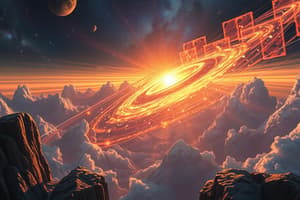Podcast
Questions and Answers
What is force and how does it relate to motion?
What is force and how does it relate to motion?
Force is a push or pull that acts on an object, causing it to change its speed or direction. Force is directly related to motion, as it is the cause of any change in an object's motion.
Explain the difference between balanced and unbalanced forces.
Explain the difference between balanced and unbalanced forces.
Balanced forces occur when the total force on an object is zero, resulting in no change in motion. Unbalanced forces occur when the total force on an object is not zero, causing the object to accelerate in the direction of the net force.
Describe Newton's three laws of motion.
Describe Newton's three laws of motion.
Newton's first law states that an object at rest will stay at rest, and an object in motion will stay in motion, unless acted upon by an external force. Newton's second law states that the acceleration of an object is directly proportional to the net force acting on it and inversely proportional to its mass. Newton's third law states that for every action, there is an equal and opposite reaction.
What is the importance of heredity in the classification of living beings?
What is the importance of heredity in the classification of living beings?
Explain the concept of physiological structure and its significance in life processes.
Explain the concept of physiological structure and its significance in life processes.
How does force impact motion in the context of physics?
How does force impact motion in the context of physics?
Flashcards
What is Force?
What is Force?
A push or pull on an object causing a change in speed or direction. It's the cause of changes in motion.
Balanced Forces
Balanced Forces
Forces where the total force on an object equals zero, so there is no change in motion.
Unbalanced Forces
Unbalanced Forces
Forces where the total force on an object is not zero, causing acceleration in the direction of the net force.
Newton's First Law
Newton's First Law
Signup and view all the flashcards
Heredity in Classification
Heredity in Classification
Signup and view all the flashcards
Physiological Structure
Physiological Structure
Signup and view all the flashcards




